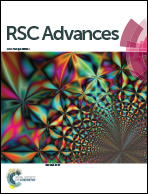Optimizing electron-rich arylamine derivatives in thiophene-fused derivatives as π bridge-based hole transporting materials for perovskite solar cells†
Abstract
Based on the observations of thienothiophene derivatives as π-bridged small molecule hole transporting materials (HTMs), adjusting their electron-rich arylamine derivatives is an effective approach to obtain the alternative HTMs for perovskite solar cells (PSCs). In this work, starting from a new electron-rich arylamine derivative and different π-bridged units of thienothiophene derivatives, a series of arylamine derivative-based HTMs were designed, and their properties were investigated using density functional theory combined with the Marcus charge transfer theory. Compared with the parental Z26 material, the designed H01–H04 exhibit appropriate frontier molecular orbitals, good optical properties, better solubility, good stability and higher hole mobilities. H01–H04 materials with high hole mobility (∼× 10−2) can serve as promising HTMs for improving the efficiency of PSCs. The results confirm that the design strategy of adjusting the electron-rich arylamine derivatives in thienothiophene derivatives as π-bridged HTMs is a reliable approach to obtain the promising HTMs for PSC applications.



 Please wait while we load your content...
Please wait while we load your content...